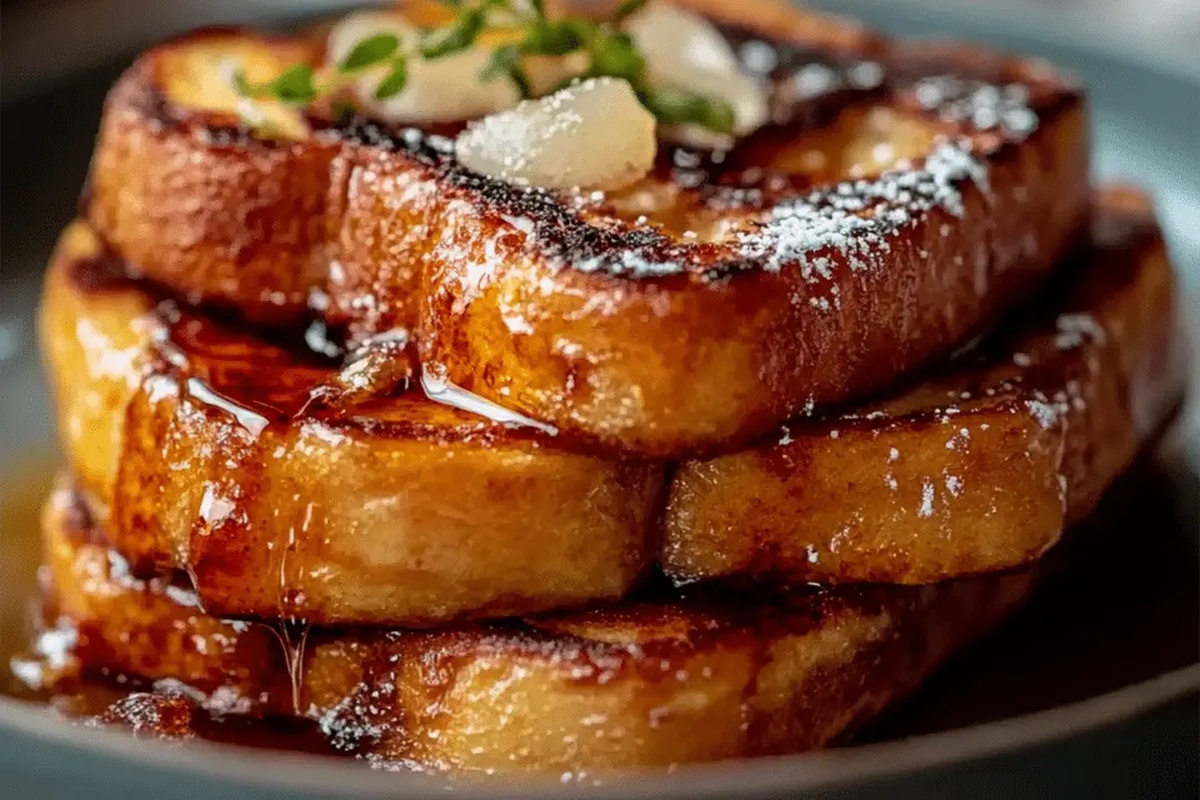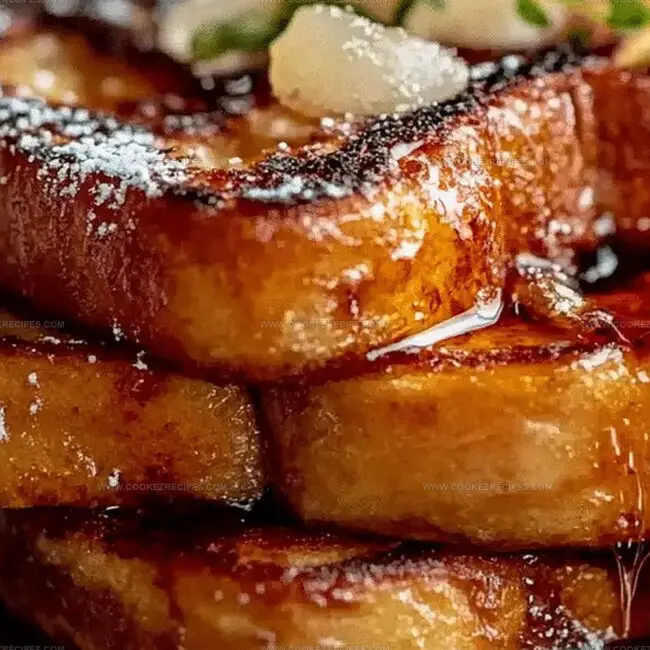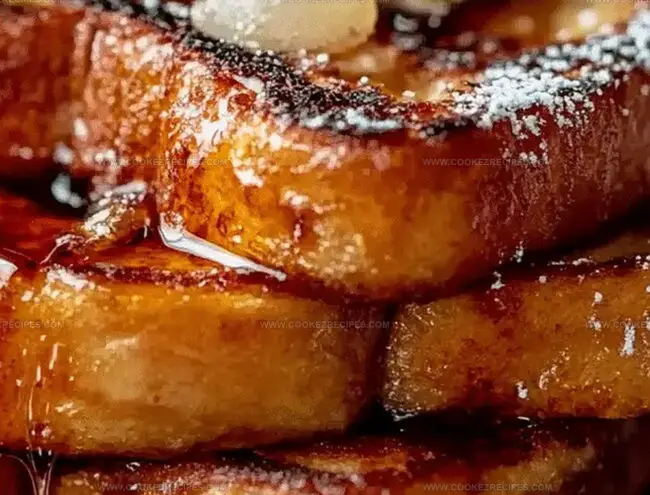Classic French Toast Recipe to Start Your Sunday
Morning sunlight catches the golden edges of classic french toast, making breakfast feel like a sweet celebration.
Crisp bread soaks in a luxurious egg mixture, promising delectable bites ahead.
Cinnamon whispers its warm fragrance through the kitchen, inviting everyone to the table.
Simple ingredients combine to create something magical and comforting.
Memories of weekend breakfasts drift through your mind as the first slice sizzles.
Each piece promises a perfect balance of soft interior and caramelized exterior.
Warm maple syrup stands ready to transform this humble dish into pure morning bliss.
Come savor a breakfast that turns ordinary moments into delicious memories.
Reasons To Make Classic French Toast Over And Over
Classic French Toast Soaking Mixture
Wet Ingredients:Bread:Cooking and Finishing Ingredients:Classic French Toast Making Process
Step 1: Whip Up the Magical Egg Mixture
In a spacious mixing bowl, blend eggs, milk, vanilla extract, a sprinkle of cinnamon, and a pinch of salt.
Whisk everything together until the mixture looks smooth and well-combined, creating a golden custard-like base for your French toast.
Step 2: Prepare the Cooking Surface
Warm up a skillet or griddle over medium heat.
Lightly coat the surface with butter or cooking oil to prevent sticking and add extra flavor.
The pan is ready when it gives off a gentle sizzle.
Step 3: Soak the Bread
Gently dunk each bread slice into the egg mixture, making sure both sides get a nice, even coating.
Let the bread absorb the liquid briefly, but avoid soaking it so much that it becomes soggy and falls apart.
Step 4: Cook to Golden Perfection
Carefully place the coated bread onto the heated skillet.
Cook for 2-3 minutes on each side, watching for a beautiful golden-brown color and crispy edges.
The bread should look and smell irresistibly delicious.
Step 5: Repeat and Keep Warm
Continue the process with remaining bread slices, adding more butter or oil to the pan as needed.
Keep cooked French toast warm on a plate in a low-temperature oven if preparing multiple servings.
Step 6: Dress and Serve
Transfer the French toast to serving plates.
Top with your favorite garnishes like:Enjoy your delectable breakfast creation while it’s warm and crispy!
French Toast Tips That Keep It Classic
French Toast Keeps Its Fluff with Gentle Reheat
Bright Flavors With French Toast
Traditional French Toast Styles
FAQs
Slightly stale or day-old bread like brioche, challah, or thick-cut white bread are ideal because they absorb the egg mixture better without falling apart and create a richer, more custardy texture.
Don’t soak the bread too long in the egg mixture. A quick dip on both sides is enough. Use bread that’s a day old and slightly firm, which helps maintain structure and prevents excess moisture.
Yes, you can substitute milk with alternatives like almond milk, coconut milk, or even cream. Each alternative will provide a slightly different flavor and richness to your French toast.
Medium heat allows the bread to cook evenly, creating a golden-brown exterior while ensuring the inside is fully cooked and custardy without burning the surface.
Print
Classic French Toast Recipe
- Total Time: 25 minutes
- Yield: 4 1x
Description
Indulgent classic French toast brings golden-brown, crispy edges and custardy centers straight from Paris kitchens. Sweet maple syrup and delicate cinnamon dust make this breakfast favorite irresistible for weekend mornings you’ll savor.
Ingredients
Main Protein:
- 4 large eggs
Bread:
- 8 slices thick-cut bread (brioche or challah works best)
Liquid and Seasoning Ingredients:
- 1 cup milk (whole or your choice of dairy alternative)
- 1 teaspoon vanilla extract
- 1/2 teaspoon ground cinnamon (optional)
- 1 pinch salt
Cooking Fat:
- Butter or oil, for cooking
Instructions
- Whisk eggs, milk, vanilla, cinnamon, and salt in a spacious mixing vessel until thoroughly combined, creating a silky custard-like batter.
- Warm a skillet or griddle over medium heat, lightly greasing the surface with a thin layer of butter or cooking oil to prevent sticking.
- Gently immerse each bread slice into the egg mixture, allowing each side to absorb the liquid without becoming overly saturated.
- Carefully transfer the coated bread to the heated cooking surface, ensuring even placement and maximum contact with the pan.
- Cook each slice for approximately 2-3 minutes, monitoring the underside until it transforms into a rich, golden-amber hue.
- Flip the toast and repeat the cooking process, achieving an equally bronzed and crisp exterior on the opposite side.
- Continue the process with remaining bread slices, replenishing butter or oil in the skillet as necessary to maintain consistent heat and prevent burning.
- Transfer the prepared French toast to serving plates, presenting them while warm and inviting.
- Embellish with preferred accompaniments such as pure maple syrup, vibrant fresh berries, a delicate sprinkle of powdered sugar, or a dollop of whipped cream for an indulgent finishing touch.
Notes
- Choose slightly stale bread like brioche or challah for better absorption and crispier texture.
- Avoid soaking bread too long to prevent soggy, falling-apart pieces that won’t hold their shape during cooking.
- Add a pinch of nutmeg or orange zest to the egg mixture for an unexpected flavor complexity that elevates the classic recipe.
- Use non-dairy milk and egg substitute for a vegan version, ensuring similar consistency with alternatives like almond milk and ground flaxseed.
- Prep Time: 10 minutes
- Cook Time: 15 minutes
- Category: Breakfast, Snacks, Desserts
- Method: Frying
- Cuisine: French
Nutrition
- Serving Size: 4
- Calories: 320
- Sugar: 6 g
- Sodium: 350 mg
- Fat: 15 g
- Saturated Fat: 6 g
- Unsaturated Fat: 7 g
- Trans Fat: 0 g
- Carbohydrates: 38 g
- Fiber: 2 g
- Protein: 10 g
- Cholesterol: 210 mg




Daniel Bruns
Founder & Culinary Innovator
Expertise
Recipe development for home cooks, Nutritional analysis and meal planning, Culinary education and food writing
Education
Auguste Escoffier School of Culinary Arts
Diploma in Culinary Arts and Operations
Focus: Classical and contemporary cooking techniques, Culinary entrepreneurship and kitchen management, Menu development and food cost analysis
Daniel’s story started with flour on his face and a pie in the oven at his grandma’s house. He later sharpened his skills at the Auguste Escoffier School of Culinary Arts.
His goal? Recipes so simple you’ll want to cook every night. When he’s not whipping up one-pan wonders, Daniel’s outside picking herbs, hosting neighborhood cook-offs, or baking chocolate cakes with his kids, messy, sweet, and unforgettable.